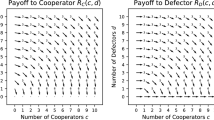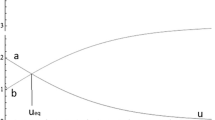Summary
Two models of conditions for the evolution of polygyny are treated axiomatically. Both models assume a social system based on female mate choice in situations in which a female is better off if she mates polygynously with an already mated male on a superior territory than if she selects a bachelor on an inferior territory. One model, the competitive female choice model, assumes that the females of a harem compete for the limited resources of the harem and thus that their fitness decreases as co-wives are added. The cooperative female choice model assumes that, within limits, a female's fitness is improved by the addition of co-wives to her mate's harem, as a result of cooperative interactions within the group. For each model, a sufficient set of independent assumptions is provided. Implications of the models are indicated and methods for testing them are discussed.
Similar content being viewed by others
References
Allee, W.C.: Animal aggregations: A study in general sociology, p. 431. Chicago: Univ. of Chicago Press 1931
Allee, W.C.: Cooperation among animals with human implications, p. 233. New York: Henry Schuman 1951
Altmann, S.A.: Baboons, space, time, and energy. Amer. Zool. 14, 221–248 (1974)
Bartholomew, G.A.: A model for the evolution of pinniped polygyny. Evol. 24, 546–559 (1970)
Buechner, H.K., Schloeth, R.: Ceremonial mating behavior in Uganda Kob (Adenota kob thomasi Neumann). Z. Tierpsychol. 22, 209–225 (1965)
Case, N.A., Hewitt, O.H.: Nesting and productivity of the Redwinged Blackbird in relation to habitat. Living Bird 2, 7–20 (1963)
Darwin, C.: The descent of man and selection in relation to sex, 1st ed., pp. 423+475. London: John Murry 1871
Downhower, J.F., Armitage, K.B.: The yellow-bellied marmot and the evolution of polygamy. Amer. Nat. 105, 355–370 (1971)
Eisenberg, J.F.: The social organization of mammals. Handb. Zool. 10, 1–92 (1966)
Elliot, P.F.: Longevity and the evolution of polygamy. Amer. Nat. 109, 281–287 (1975)
Emlen, S.T., Oring, L.W.: Ecology, sexual selection, and the evolution of mating systems. Science 197, 215–223 (1977)
Fisher, R.A.: The genetical theory of natural selection. 2nd ed., p. 291. New York: Dover Publ. 1958
Goddard, S.V., Board, V.V.: Reproductive success of Red-winged Blackbirds in north-central Oklahoma. Wils. Bull. 79, 283–289 (1967)
Haigh, C.R.: Sexual dimorphism, sex ratios, and polygyny in the Redwinged Blackbird, p. 116. Seattle: Ph.D. Dissertation Univ. of Washington 1968
Holm, C.H.: Breeding, sex ratios, territoriality, and reproductive success in the Red-winged Blackbird (Agelaius phoeniceus). Ecol. 54, 356–365 (1973)
Jarman, P.J.: The social organization of antelope in relation to their ecology. Behaviour 48, 215–267 (1974)
Jenni, D.A.: Evolution of polyandry in birds. Amer. Zool. 14, 129–144 (1974)
Kropotkin, P.: Mutual aid, a factor in evolution, p. 223. New York: Knopf 1914
Kummer, H.: Social organization of hamadryas baboons: a field study, p. 189. Chicago: Univ. of Chicago Press; Basel: S. Karger (Bibliotheca Primatologica No. 6) 1968
Lack, D.: Ecological adaptations for breeding in birds, p. 409. London: Methuen 1968
Lazarus, J.: Natural selection and the functions of flocking in birds: A reply to Murton. Ibis 114, 556–558 (1972)
Lenington, S.: The evolution of polygyny in red-winged blackbirds. Ph.D. Dissertation, Dept. of Biol., Univ. of Chicago (1977)
Mayr, E.: The sex ratio in wild birds. Amer. Nat. 73, 156–179 (1939)
Mohr, E.: Das Verhalten der Pinnipedier. Handb. Zool. 8, 1–20 (1956)
Murton, R.K.: Why do some birds feed in flocks. Ibis 113, 534–536 (1971)
Orians, G.H.: On the evolution of mating systems in birds and mammals. Amer. Nat. 103, 589–603 (1969)
Orians, G.H.: Ecological aspects of behavior. In: Avian biology (eds. D. Farner, J.R. King), pp. 513–546. New York: Academic Press 1971
Orians, G.H.: The adaptive significance of mating systems in the Icteridae, pp. 389–398. Proc. XVth Int. Ornith. Congr. 1972
Parsons, T.: Societies: evolutionary and comparative perspectives, p. 120. Englewood Cliffs, N.J.: Prentice-Hall 1966
Skutch, A.F.: The parental strategems of birds. Ibis 96, 544–564 (1955)
Skutch, A.F.: Helpers among birds. Condor 63, 198–226 (1961)
Skutch, A.F.: Parental birds and their young, p. 503. Austin: Univ. of Texas Press 1976
Verner, J.: Evolution of polygamy in the long-billed marsh wren. Evol. 18, 252–261 (1964)
Verner, J., Willson, M.F.: The influence of habitat on mating systems of North American passerine birds. Ecol. 47, 143–147 (1966)
Willson, M.F.: Breeding ecology of the yellow-headed blackbird. Ecol. Monogr. 36, 51–77 (1966)
Willson, M.F., Pianka, E.R.: Sexual selection, sex ratio, and mating system. Amer. Nat. 97, 405–407 (1963)
Wittenberger, J.F.: The ecological factors selecting for polygyny in birds. Amer. Nat. 110, 779–799 (1976)
Wynne-Edwards, V.C.: Animal dispersion in relation to social behaviour, p. 653. Edinburgh and London: Oliver and Boyd 1962
Author information
Authors and Affiliations
Rights and permissions
About this article
Cite this article
Altmann, S.A., Wagner, S.S. & Lenington, S. Two models for the evolution of polygyny. Behav Ecol Sociobiol 2, 397–410 (1977). https://doi.org/10.1007/BF00299508
Received:
Issue Date:
DOI: https://doi.org/10.1007/BF00299508




